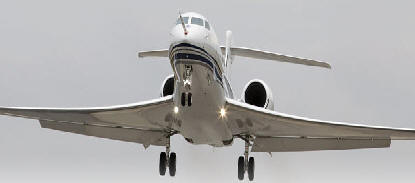
NEWSROOM
 |
NEWSROOM |
|
|
|
|
|||
|
Gulfstream
G650 Jet Passes Initial Flight Tests By Mike Mitchell (see Gulfstream G650 Makes First Successful Flight) |
||||
 |
December 5, 2009 — Gulfstream Aerospace, announced that the
ultra-large-cabin, ultra-long-range Gulfstream G650 has successfully
completed its first series of flight tests. During a 1-hour and
45-minute flight, G650 project pilot Jake Howard and senior experimental
test pilot Tom Horne, along with flight engineer Bill Osborne, tested
the aircraft’s handling qualities, engine operability and flap
operation.
Additionally, the crew evaluated the aircraft’s pitot static systems,
avionics, hydraulic systems, electrical power generation and
distribution, flight controls, and cabin environmental and
pressurization controls. |
|||
|
“The pilots’ reports indicate that the G650’s flying qualities were
outstanding,” said Pres Henne, senior vice president, Programs,
Engineering and Test, Gulfstream.
“With its cutting-edge technology, the aircraft performed
superbly, as we expected it would. We are very excited to continue our
flight-test program and look forward to certification in 2011.”
Gulfstream announced the G650 program on March 13, 2008. On Sept. 29,
2009, the aircraft rolled out under its own power in front of a crowd of
more than 7,000 people. It completed its first flight on Nov. 25, 2009,
and remains on schedule for entry-into-service in 2012.
The G650 will fly at cruise speeds of Mach 0.85 to 0.90, with maximum
speed of Mach 0.925 and will have a range of up to 7,000 nmi (13,000
km). It will be equipped with a full kitchen and bar and may be equipped
with a variety of entertainment features including satellite phones and
wireless Internet. The new jet will use the new Rolls-Royce BR725 engine
producing a maximum thrust of 17,000 pounds-force (75.6 kN). Gulfstream
states that with a weight of less than 100,000 pounds (45,360 kg), it
will be able to land at small airports avoiding the busy airports around
the world. |
||||
|
To provide better usage of the internal volume, Gulfstream designers
rejected the usual circular fuselage cross-section in favor of an oval
with uses a flatter lower portion. The cabin is to be 8 feet 6 inches
wide and 6 feet 5 inches high. The fuselage is of metal construction and
Composite construction is used for empennage, winglets, rear pressure
bulkhead, engine cowlings, cabin floor structure and many fairings. The
sixteen oval cabin windows are 28 inches (71 cm) wide.
The aircraft controls will be completely fly-by-wire, with no mechanical
control between pilot and flight surfaces. The surfaces will be moved by
a dual hydraulic system. More airliners today are using fly-by-wire, but
only one current business jet (Falcon 7X) is so equipped. The wing design was completed in 2006. Models have been wind-tunnel tested, with a total of 1,400 hrs of testing planned before the end of 2008. A pressure-test fuselage has been built and tested, including an ultimate-pressure test of 18.37 psi. The G650 taxied under its own power for the first time on September 26, 2009. A public rollout ceremony was later held on September 29, 2009. First flight for the G650 occurred on November 25, 2009. |
| ©AvStop Online Magazine Contact Us Return To News |
|